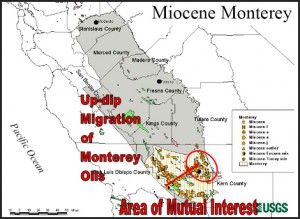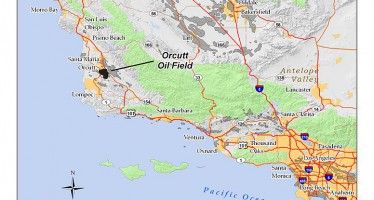CA Boasts 2/3 of U.S. Shale Oil Reserves
By WAYNE LUSVARDI
Back on Dec. 21, 2011, Gov. Jerry Brown said at a Jewish Menorah-lighting ceremony, “Today’s miracle is not to find more oil, but to utilize the sun.” Brown was touting solar energy projects.
But the solution to Brown’s structural $20 billion annual state budget deficit may not be in the sky but under his feet. Particularly if Brown is standing any place where the Monterey Shale Formation is underneath. That would include the counties of Kern, Ventura, Santa Barbara, Fresno, Monterey, Tulare, San Luis Obispo, Kings, Madera, Merced, Stanislaus and San Benito.
The reason is that there may be a resurgence of the historic oil patches in California. This is the result of updated estimates of the recoverable barrels of shale oil due to new extraction technologies.
The Monterey Shale Formation in California is estimated to have 64 percent — repeat 64 percent — of the recoverable shale oil reserves in the lower 48 states.
Below is a recapitulated table from the U.S. Energy Information Administration report, “Review of Emerging Resources: U.S. Shale Gas and Shale Oil Plays — July 2011”:
Recapitulated Table of U.S. Technically Recoverable Shale Oil Resources
| Play | Technically Recoverable Resource
Oil – Billions Barrels of Oil-BBO |
Area in Square Miles | Average EUR
Oil — Million of Barrels of Oil per Well |
| GULF COAST | |||
| Eagle Ford Formation
Texas |
3.35 BBO
13.9 Percent |
3,323 | 300 |
| SOUTH WEST | |||
| Avalon & Bone Springs Formation
New Mexico & West Texas |
1.58 BBO
6.5 Percent |
1,313 | 300 |
| ROCKY MOUNTAIN | |||
| Bakken Formation
Montana, No. Dakota & Canada |
3.59 BBO
15.0 Percent |
6,522 | 550 |
| WEST COAST | |||
| Monterey-Santos Formation – California | 15.42 BBO
64.4 Percent |
1.752 | 550 |
| TOTAL 48 STATES | 23.94 BBO
100 Percent |
12,910 | 460 |
Source: U.S. Energy Information Administration .pdf, July 2011
Abundant Shale Oil
California may have more than four times the recoverable shale oil than the Bakken Oil Field in North Dakota, which currently is bringing vast prosperity to that state. It has more than 4.5 times the reserves of the Eagle Ford Formation in Texas. And it has nearly 10 times the shale oil reserves in the Avalon and Bone Springs Formations in New Mexico and Texas.
This is how the U.S. Energy Information Administration describes it:
“The largest shale oil formation is the Monterey/Santos play in southern California, which is estimated to hold 15.4 billion barrels or 64 percent of the total shale oil resources shown in Table 1. The Monterey shale play is the primary source rock for the conventional oil reservoirs found in the Santa Maria and San Joaquin Basins in southern California. The next largest shale oil plays are the Bakken and Eagle Ford, which are assessed to hold approximately 3.6 billion barrels and 3.4 billion barrels of oil, respectively.”
Remember the days when the Southern California economy was built on oil and movies? The birthplace of the oil industry may have been Pennsylvania, but it quickly spread to Long Beach, Ventura, Huntington Beach and San Luis Obispo County.
Will oil derricks and rigs return to Santa Barbara County and off the coastline? It is unlikely and not necessary with new horizontal drilling techniques.
California continues to try to erect an energy embargo around California with its Cap and Trade regulations and AB 32 mandates to plug its structural $20 billion annual budget deficit.
But ironically, California is sitting on a potential second resurgence of its oil patch that might be able to patch up the state budget deficit and sharply cut unemployment.
The state budget deficits are not solely due to a prolonged economic downturn. They are a choice.
Related Articles
Santa Barbara picks drilling over greening
Santa Barbara is ground zero for the environmental movement in California after the infamous Union Oil Company oil spill in
Pelican Bay Gallows Humor
Anthony Pignataro: It must be difficult for state Department of Corrections and Rehabilitation press office to write snappy, crisp news
Budget fight shows unlikelihood of fed $ for bullet train
Congress’ most intense squabbles over the $1.1 trillion omnibus spending plan that passed Saturday weren’t over the budget details. They





